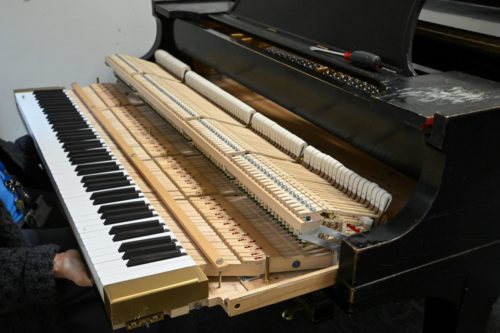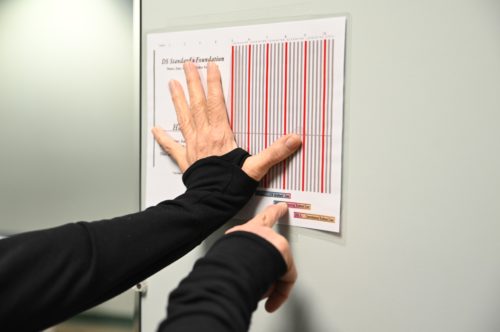By Anna Reguero
Because pianists bear down on the keyboard with force and their fingers volley across the keys in nimble gymnastics, they are some of the most at-risk musicians for injury. To combat injury, Eastman has a smaller-sized keyboard on loan for the 2024-25 academic year that reduces strain on petite hands. It’s not a whole piano, but a keyboard insert that slots into and alters a piano of choice.
Piano keys are long levers of wood that, when pressed, cause a hammer to strike the piano’s strings. It is an action that can be pulled out and removed from a piano. The company DS Standard Foundation (previously Steinbuhler & Company) developed a removable insert, turning any piano into an adaptive size. The company makes two sizes to accommodate a variety of hand sizes: a universal size that is 15/16ths of a standard keyboard, reducing an octave by a half inch, and an even smaller one that is 7/8ths of a standard size.

A reduced-sized keyboard—on loan to Eastman this academic year—is inserted into a grand piano to change the size of the keys for smaller hands. Photo by Kerry Lubman.
It means that pianists who don’t have the same lanky fingers of Romantic-era pianist and composer Franz Liszt—who wrote music with gargantuan intervals—might still be able to reach the keys when the repertoire demands inhuman hand spans.
“Even if you’re not just trying to get a stronger, larger reach, it’s less stressful on your hands,” says Robert Wilkinson, Eastman’s manager of instrument services.
These adaptive keyboards seem like a promising solution for pianists, especially if such inserts could be available in every major concert hall. But even though these inserts fit specific piano models—such as the seven-foot Steinway B that currently houses the insert at Eastman—they need to be adjusted and tuned for the particular piano. They have not yet become a ubiquitous option for professional players. Even so, Eastman pianists so far claim that the reduced size doesn’t affect their ability to go back to a full-size piano yet aids significantly in enduring long practice sessions.

Hand measurements are used to determine the best sized keyboard for a performer. Photo by Anna Reguero.
To understand the impact of these reduced-size keyboards, UHS physical therapist Susanne Callan-Harris and her colleagues are collecting usage data from Eastman pianists to understand the impact of the smaller keys on injury rates. Eastman hopes to purchase the insert that is currently on loan and add the smaller-sized insert to the options for pianists. The inserts that can interchange with the full-size keyboard cost upwards of $17,000. While it isn’t inexpensive, it is much less than buying a brand-new Steinway. And, “hand surgery is certainly more than that,” says Wilkinson.
Callan-Harris thinks it’s a necessary investment. “My dream would be to have students come in day one, find out their ideal size, and learn on their ideal size keyboard from the very beginning, and go through the Eastman School of Music with the expectation that they should have an instrument that’s suited to them.”
